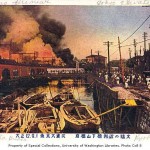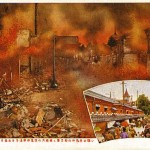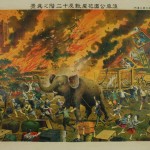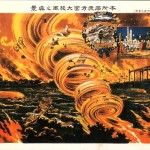
When a natural disaster strikes a nation, it leaves the nation’s people vulnerable to danger and uncertainty. These risks are not limited to just the physical wreckage, but also penetrates the political and psychological environment. The period of unrest and insecurity following a disaster is a dangerous one that has the potential to bring to the surface false notions and beliefs about who is to blame for the rising crisis.
The Great Kantō Earthquake of 1923 in Japan is a prime example of how a political conflict and crisis can follow a natural disaster. As a result of the earthquake and tsunami, other incidents such as raging fires and poisoned water wells fell upon Japan’s Honshū region. (The following images are postcards that depict the fires that razed Japan’s cities.)
- Asakusa Nakamise Shopping Arcade Devoured by Flames
- Asakusa Park and Twelve Stories in Flames
- Aftermath of Great Kanto earthquake showing the fire near the Yamashita bridge in the Kyobashi district
- Aftermath of Great Kanto earthquake showing the licensed brothel district in Yoshiwara quarter burning
(More photos can be accessed here.)
Since these phenomena did not appear to be directly related to the earthquake, rumors accusing individual parties and factions of starting fires and poisoning the water started to spread. Since 1910, Korea was a colony under Japanese rule, and many Japanese civilians viewed the Koreans with suspicion of rebellion and revolution. These sentiments only fueled the rumors, and the realm of suspect also expanded to include the Chinese, Okinawans, and speakers of more local Japanese dialects.
The characters in the Japanese language, ga gi gu ge go (がぎぐげご) – though other sources may cite other ra ri ru re ro (らりるれろ) – were used as a shibboleth to identify the ethnicities of individuals.
Not only were outsiders targeted, but the vigilante violence also infiltrated Japan’s own politics. The nationalist government of Japan met opposition with unionists, socialists, and anarchists – advocates of “left-wing” thinking – and a number of radicals fell subject to the wave of civilian crime and fear.
As mentioned in a paper published by Clancey and Orihara:
“Print reactions began to extend their range beyond the traumatized and tragic, and the search for scientific explanations, to include the optimistic and even euphoric, the later condition being referred to in some disaster-studies writings as ‘post-disaster utopianism.’”
A question worth asking is, then, how far will the human condition allow such a witch hunt and a desperate, idealistic search for a resolution to go? Estimated death tolls as a result of the massacre reach up to 6,000, though the number reported by the government lies only in the hundreds.
It is interesting to consider how the after-effects of the earthquake garnered an overarching feeling of suspicion and ill-will toward a particular group of individuals, and why there existed such a need to identify and rectify a root cause. A parallel can be drawn in relating the massacres and series of crimes in 1923 to the 3/11 crisis in Japan, though in contemporary 2011, the conflict has arisen from the nuclear crisis. The victim – in some opinions, the scapegoat – is clear: Tokyo Electric Power Co. However, in targeting the utilities, the Democratic Party of Japan (DPJ) also faces public criticism for failing to properly manage the entire situation, for hesitating in making crucial decisions, and for falling short in making amends. Consequently bureaucrats look for the return of the Liberal Democratic Party (LDP), and while the political factions are reversed in this situation, there is still this growing conflict and underlying power struggle between two internal political groups in Japan.



